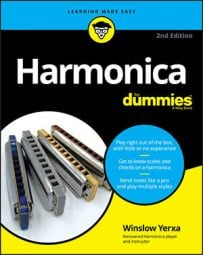To get at the reeds in a harmonica for tuning, adjustment, or to clear obstructions, you have to take the covers off. You may also need to remove the reedplates from the comb. If you’re careful, you can disassemble and reassemble a harmonica without mishap as you can watch in Chapter 18, Video Clip 1801. Just make sure there are no parts left over when you’re done.
Some harps are bolted together and some are nailed together. The processes for disassembling and reassembling are different for each type of harp.
Dealing with harps that are bolted together
To remove the covers of a harp that’s bolted together, hold the harp in the palm of one hand and use your index finger to steady one of the cover nuts while you unscrew the bolt. Place the bolt and nut in your holding container and remove any other cover bolts.
When replacing the covers, follow these directions:
Make sure the top cover (the one with the name of the harp and any numbers) is over the blow reedplate (with the reeds inside the harp).
If there are grooves in the fronts of the reedplates, align the front edges of the covers in those grooves.
Place one of the nuts in or over the hole (depending on what type it is) and hold it in place with the index finger of your holding hand.
Turn the harp over, place the bolt in the hole, and tighten it part of the way.
Install the nut and bolt in the other end of the cover the same way.
When you’re sure both covers are properly aligned, do your final tightening.
To remove the reedplates, use an appropriate screwdriver to loosen the bolts. Be sure to place the bolts in your holding container so they don’t get lost.
Before removing the reedplates, mark the outside of each one with a permanent marker so that later you can easily identify which reedplate is the top and which is the bottom. The top reedplate has the blow reeds and the bottom reedplate has the draw reeds.
Here’s how you reassemble a harp after removing the reedplates:
Place the blow reedplate on top with the reeds inside and the draw reedplate on the bottom with the reeds outside.
Make sure the long reeds match the long chambers in the comb. Line up the bolt holes in the reedplates with the matching holes in the comb.
Insert the bolts in any order and turn each one counterclockwise until you hear it click.
This makes sure that the bolt thread is aligned with the thread in the bottom reedplate. When you hear the click, turn the bolt clockwise to make sure it grabs the thread in the bottom reedplate (but don’t tighten it all the way yet).
Place the harp on a table with the holes facing down to ensure that the front edges of the reedplates are aligned with the front edges of the comb, and then tighten the bolts by starting at the center of the harp and moving outward to the right and left ends of the harp.
This procedure helps keep the reedplates flat against the comb.
Never over-tighten a screw or bolt. Tighten it only until the screwdriver resists your finger pressure (except when you’re cutting threads in a brand-new reedplate, which requires some additional pressure).
Contending with harps that are nailed together
Harps that are nailed together have to be pried apart with a stiff blade that’s slim enough to work between the cover and the reedplates and between the reedplate and the comb. The blade needs to be at least as long as the surface that you’re prying, and it needs to be stiff enough to lift it.
A jackknife blade is fine for covers, but you may need an inexpensive kitchen knife to lift reedplates. When prying up reedplates, try not to cut the comb or press an indentation into the wood.
Nails often go in at funny angles, and their heads aren’t at right angles to their shafts. Try to preserve the nails in formation so you can return each nail to its original hole. You can stick the nails into a piece of soft putty or clay or place them in sequence on the sticky side of some adhesive tape.
When reassembling nailed-together harps, press each nail into its original hole and then press it down with pliers or a hard object or tool that can press the nail without touching the reeds.
Don’t press so hard that you break the comb or warp the harp.

